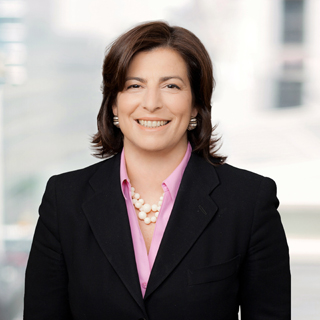
Dear Friends and Colleagues,
We talk a lot about milestones at the Edna McConnell Clark Foundation. Usually they are performance milestones or goals that we set for ourselves or help our grantees set for themselves as conditions of our investments in them. The year just passed has been full of milestones of another sort for the Foundation. Despite political and economic uncertainties, important events and turning points in our history are setting the course for our future.
Although we, our grantees and investment partners often feel as if we are still in a period of transition as we continue to navigate shifting winds and tides of great complexity, this may also be an opportunity for transformation.
The year 2010 marked the tenth anniversary of our shift in grantmaking strategy to large, multiyear investments in building the capacity and evidence base of organizations delivering effective programs to low-income young Americans. Since 2000, we have invested $220 million in 33 youth-serving organizations in a concerted effort to accelerate their growth, expand their impact, and improve the life trajectories of greater numbers of economically disadvantaged young people.
For ten years we have tested and refined our investment model, which has yielded a substantial return, thanks to the vision and hard work of an extraordinary set of dedicated nonprofit leaders and grantees. At its inception in 2000, our Youth Development Fund consisted of three grantees serving 7,624 youth annually, with total revenues of $32.7 million. In 2010, it encompassed 19 grantees serving 369,292 youth with total revenues of $570.6 million.
Our portfolio has also made progress in building its evidence base about what works. Half of our current grantees have initiated rigorous third-party evaluations while in the Youth Development Fund, and a quarter have completed them. Longtime EMCF grantees like Nurse-Family Partnership and Harlem Children's Zone are now recognized as agents of change and leaders in the field, poised to reach significant scale and make an impact on the lives of thousands more young people.
In 2010, in another milestone for the Foundation, the federal government recognized the success of our grantees and the promise of our model by making us an intermediary for the Social Innovation Fund (SIF) and enlisting our help and expertise in bringing evidence-based programs to scale. I am pleased to report that 21 outstanding youth-serving organizations, out of 225 applicants, are now finalists in our open and highly competitive selection process. They are currently undergoing due diligence, and we expect to announce eight to ten SIF grants in March.
As I have written in previous letters, we thought long and hard before deciding to apply for a SIF award. We concluded that it presents a unique opportunity to advance our strategy and help promising programs reach more young people. Achieving significant scale—not just expanding from five sites to seven, for example, but meeting the needs of tens of thousands of disadvantaged young Americans—requires the kind of creative collaboration between government and philanthropy that the SIF embodies.
Now that negotiations over the terms of our award with the Corporation for National and Community Service, which oversees the SIF, are behind us, the Foundation is deep into the grantee selection process. Although this experimental public/private partnership is a work in progress and still has a long way to go, we are inspired by the caliber of applicants we are reviewing. We are already learning from them powerful lessons that we hope will help build a stronger field of youth-serving organizations.
EMCF is proud of the sourcing and due diligence practices we have developed over the years to identify and vet prospective grantees. These procedures are open and transparent. Our website describes them in some detail. But, as a private foundation, previously we have employed them in privacy, under conditions entirely of our choosing and in our control. Opening the doors to all comers in a public competition has opened our eyes to many high-performing nonprofits we might never have discovered on our own. Our pipeline of prospective grantees has expanded significantly, and this bodes well for the continuing development in coming years of our portfolio of outstanding organizations.
Our experience during the selection process has also encouraged us to define more clearly the population that EMCF strives, through our grantees, to serve. Our target is not just economically disadvantaged young people but the most vulnerable and hardest-to-reach among them. Our grantees serve low-income youth who are, for example, in greatest danger of failing or dropping out of school, of not finding work, of becoming disconnected from both education and employment, of becoming involved in or having difficulty transitioning out of the foster care or juvenile justice system. Particularly when a weak economy punishes poor Americans disproportionately, the line between the vulnerable and the most vulnerable can easily blur, so we have become more explicit in describing how we differentiate our target population and measure grantees’ impact on it.
Conducting the SIF competition has also strengthened our relationships with our strategic collaborators, MDRC and the Bridgespan Group. As we have assessed candidates, all of us have been impressed by the growing commitment of youth-serving nonprofits to quality and evaluation, and by their interest in putting in place systems that ensure quality and permit evaluation. That said, the organizational capacity and evidence base of the field are still sparse, and the findings from our selection process reaffirm our strategy of concentrating on these prerequisites for impact, scale and sustainability. Working closely with Bridgespan and MDRC during the first few months of the selection process has underscored the potential power of thinking about funding, capacity building, evaluation and growth within an integrated framework, because each element has implications for the others.
After a decade of helping grantees grow, EMCF is humbled by how hard it is and long it takes to build the requisite evidence and capacity for scale. A major reason is the inefficient way funding flows to nonprofits. We are more convinced than ever that a better-organized capital market would make things much easier for nonprofits—and much better for economically disadvantaged youth. Given our staggering rate of youth unemployment, our low ranking in international educational surveys, our swollen prison population and other indications that America is falling behind in the global marketplace, we cannot remain competitive without tackling some of these problems at scale.
EMCF is not unique among funders in realizing that we can no longer go it alone—that once we have found programs that work, scaling them requires additional capital from other sources. We are gratified by the number of other funders that have joined or expressed interest in joining us to reduce the burden on SIF grantees of matching the funds that the government and the Foundation invest in them. Before we applied to become an intermediary, four philanthropies—the George Kaiser Family Foundation, the Duke Foundation, Tipping Point Community and the Open Society Foundations—committed a total of $17 million over three years to our SIF grantees that meet their own grantmaking criteria.
One of our first orders of business in 2011 is adding other funders to their ranks. By aggregating and delivering upfront large infusions of capital for building evidence and organizational capacity, we hope to demonstrate a more effective model of organizing private and public capital on behalf of low-income youth. This initiative will extend and take to a higher level the investment approach we tested with the Growth Capital Aggregation Pilot (GCAP) that we launched in 2007.
Another milestone in 2010 was reaching the three-year mark with GCAP. It would be premature, especially given the uncertainty of the political and economic environment, to declare this experiment in coordinated, collaborative philanthropy a victory, but the results so far are quite promising. All three GCAP grantees are in a stronger position today, even under adverse economic conditions, than they were when the pilot began. They serve more young people, they earn more revenue, and they are poised for public investment that can propel them to scale and sustainability. Encouraged by these initial signs of success, we plan to extend and adapt growth capital aggregation to our SIF grantees and other organizations.
Is there a tipping point when a transitional period turns into a long-term shift of emphasis in philanthropy and public policy? Today, there is much interest among funders and policymakers in the evidence-based grantmaking that EMCF has long championed. Capital aggregation is also attracting increasing attention. Yet a queasy economy and unpredictable shifts in political power make it unclear how long the trend toward scaling what works will continue to our advantage, and to that of low-income youth.
In March we will be sharing more information about the SIF and announcing the grantees we have selected. In the meantime, I wish you a happy New Year—and, for the Foundation, our grantees and our co-investors, many more milestones.
Sincerely,
Nancy Roob




